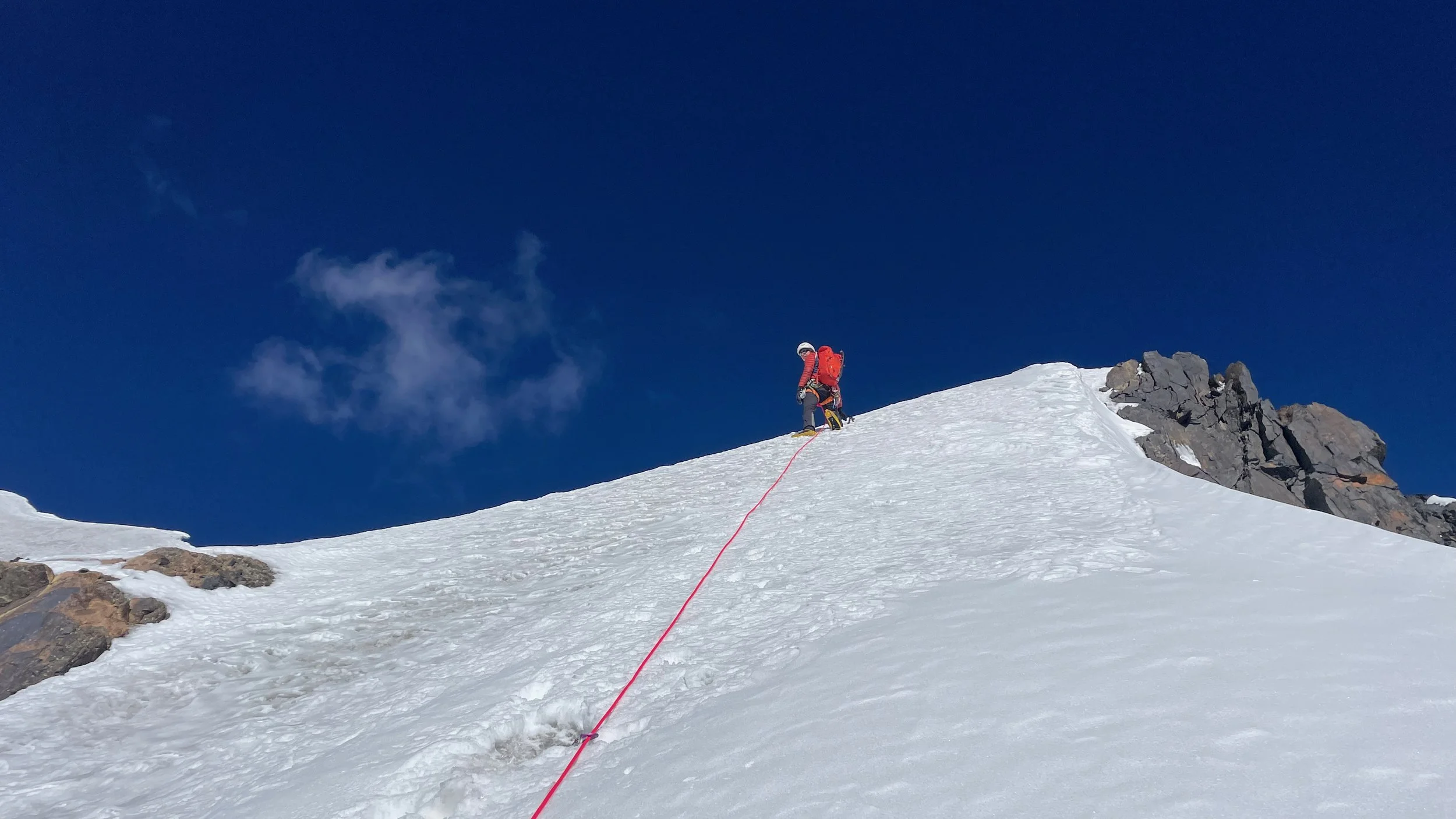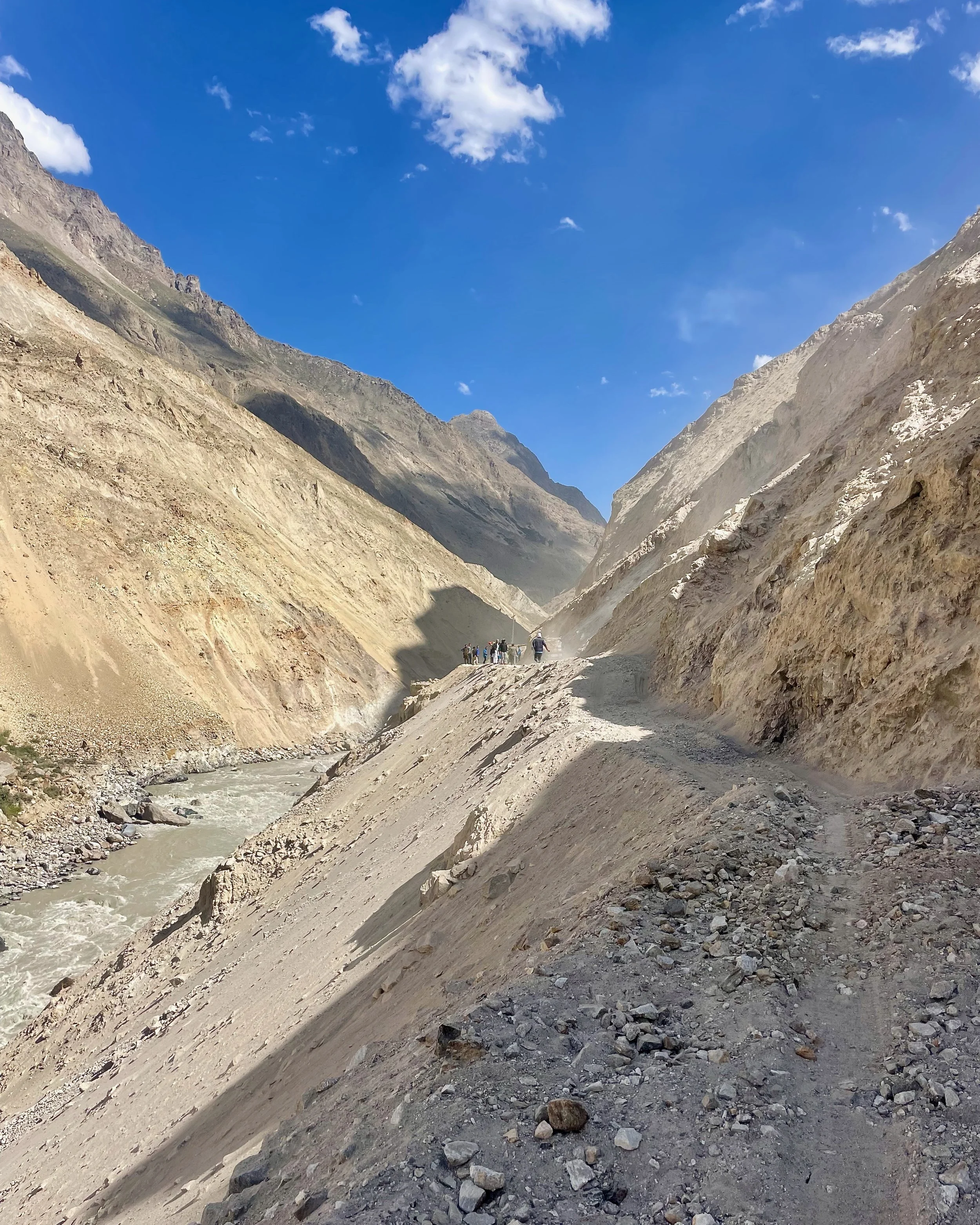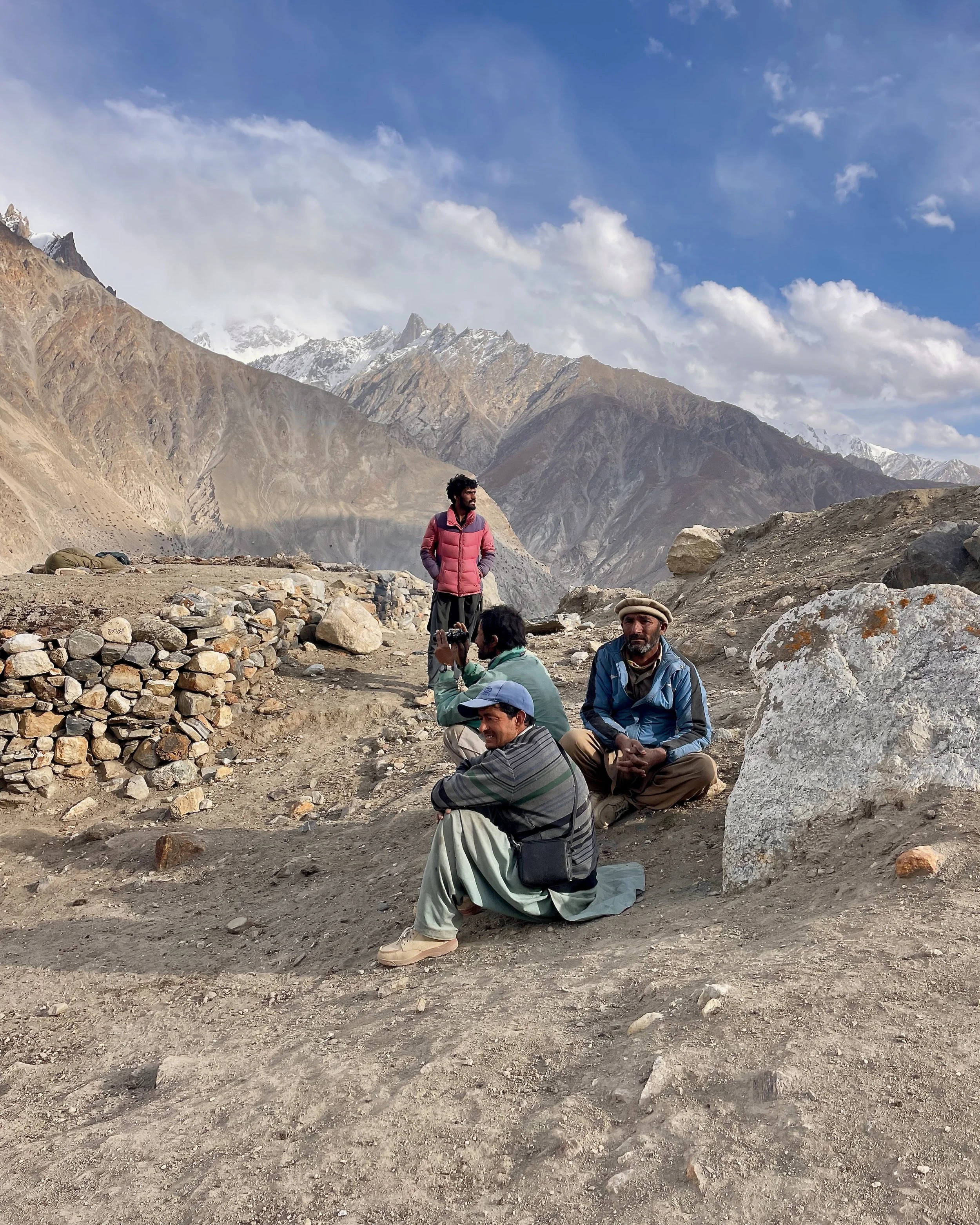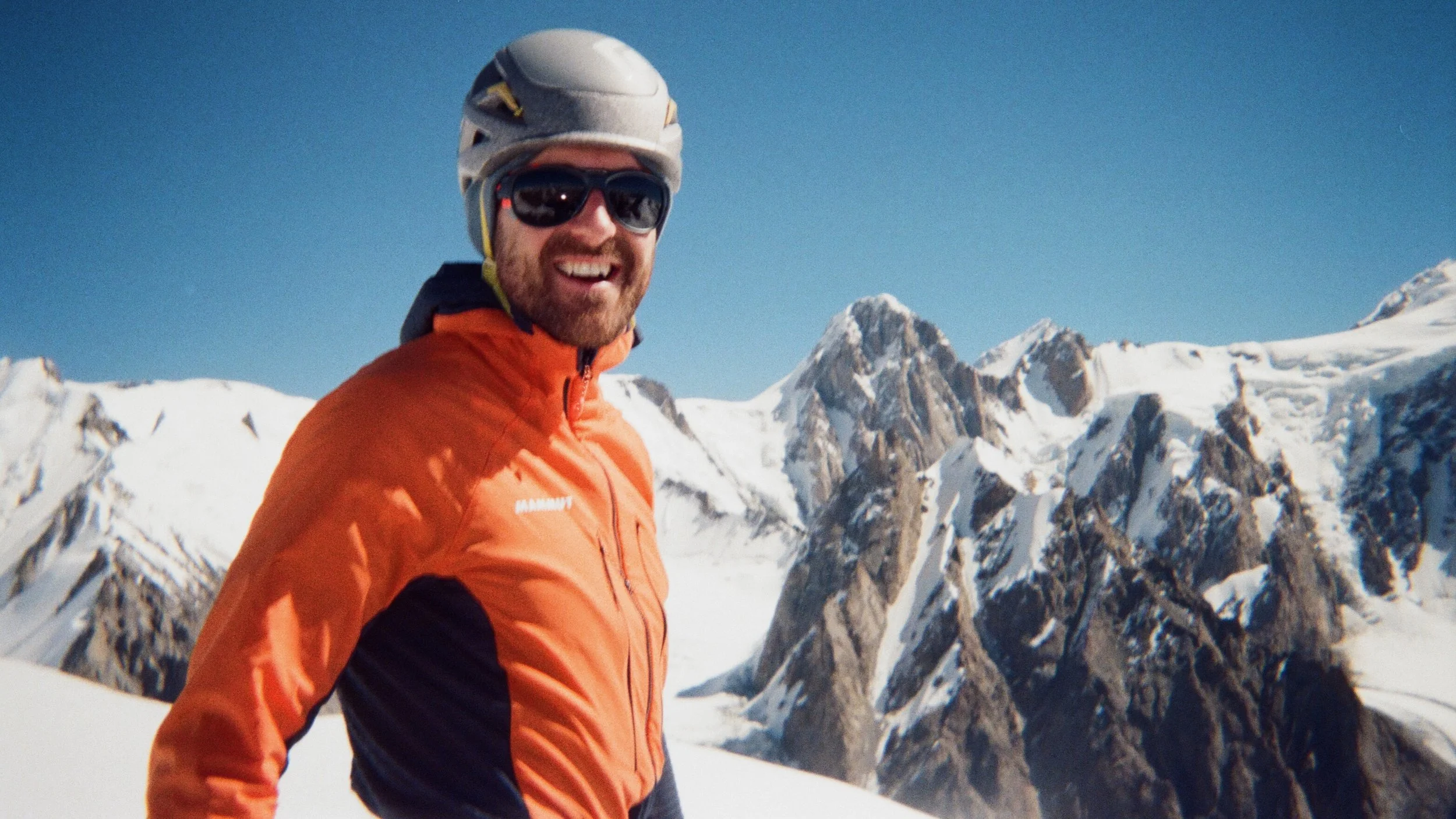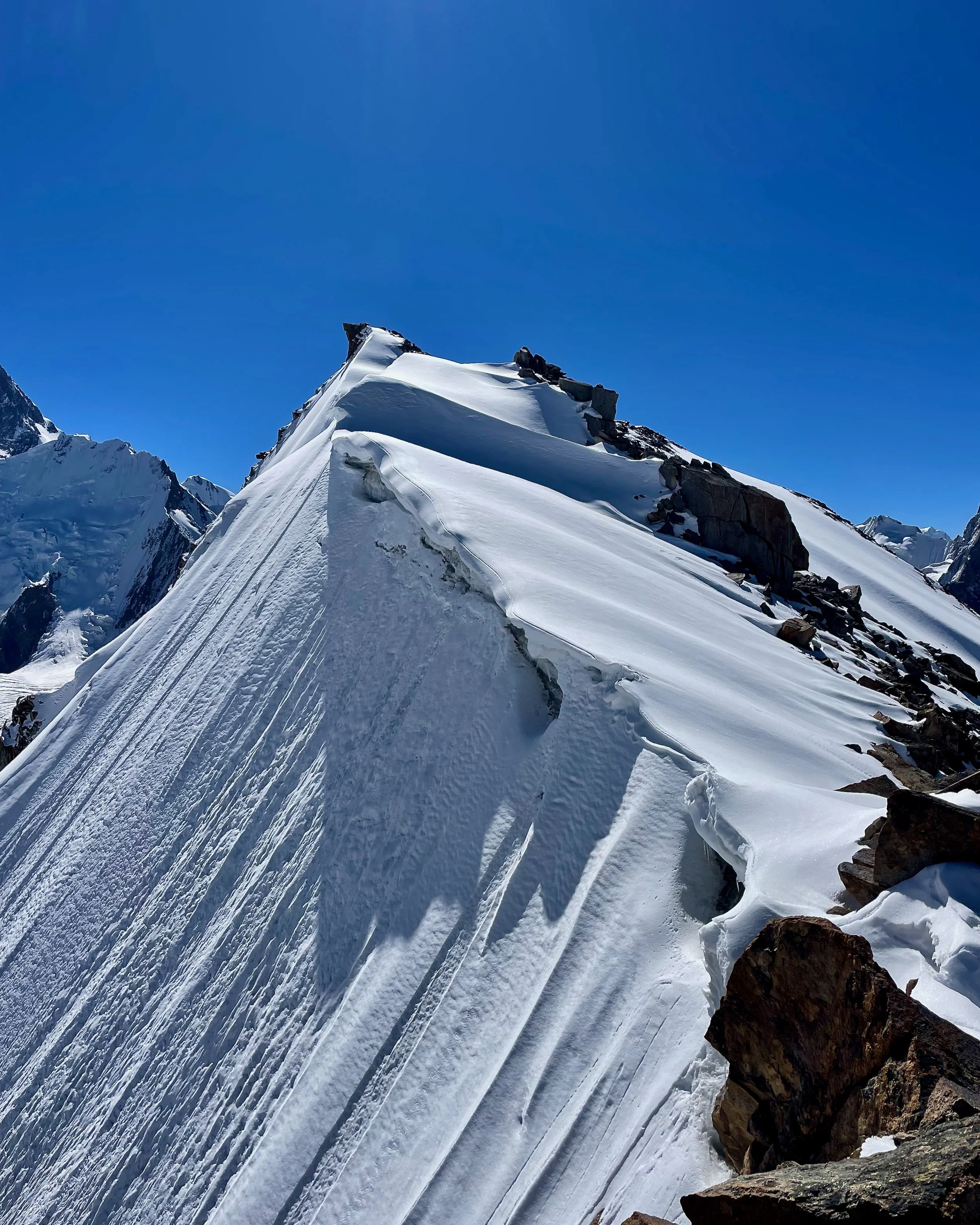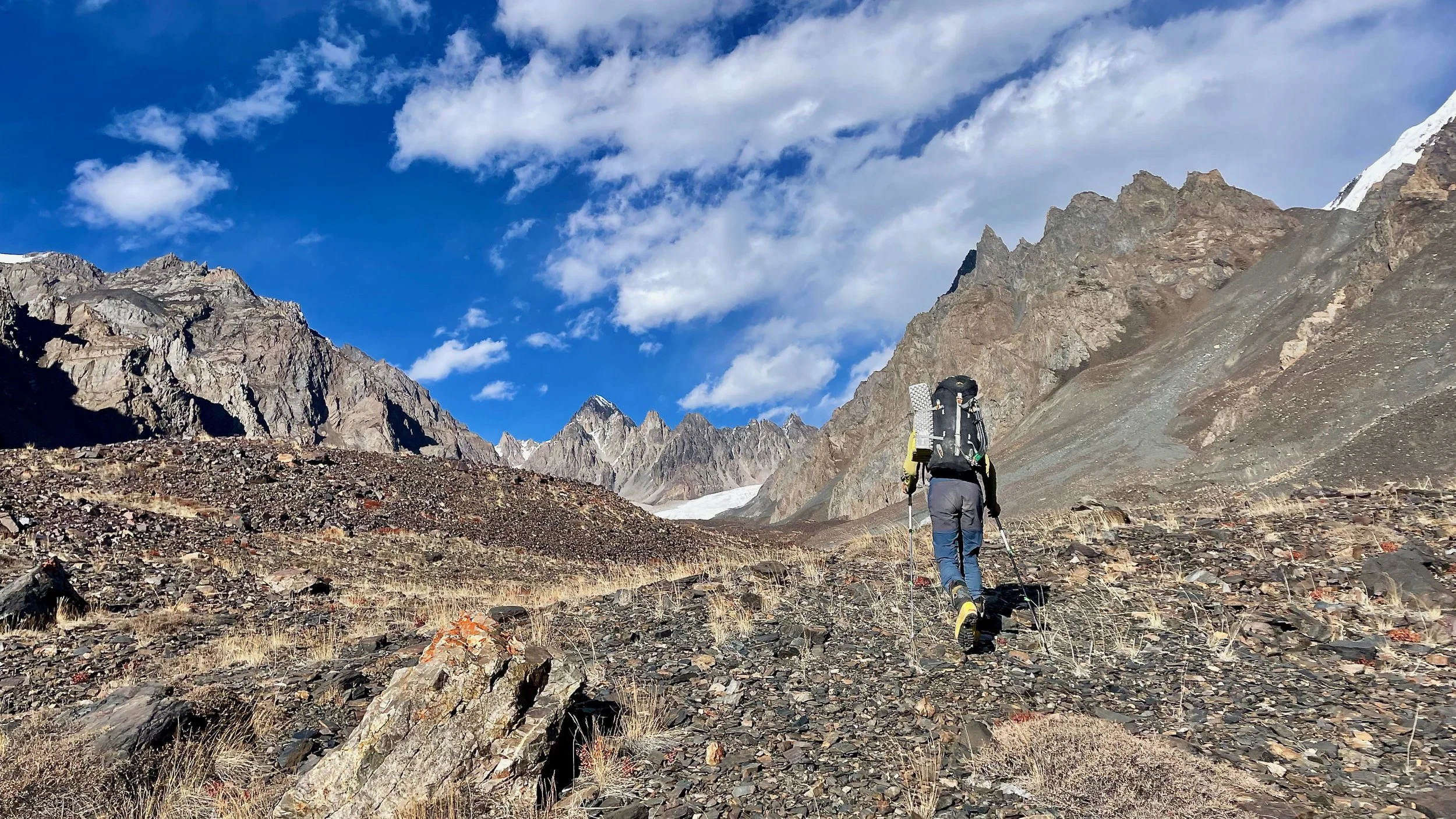Closer to the Edge: Pakistan 2024
Leo Kesner gains the west ridge of an unclimbed peak of unknown height in the Hunza Valley, Pakistan Karakoram.
We arrive in Islamabad, built on the Pothohar Plateau in northern Punjab, on 10 September and meet Ibrar, a local guide whom Karim, our agent in Pakistan, has arranged to host us for the day. A short drive in an air-conditioned minivan takes us to the national Pakistan Monument in the western Shakarparian Hills, a striking construction of Indo-Islamic architecture built to represent the strength and unity of a people of a free and independent state. I talk with students and locals and tell them they are the future of their country, for they have a great love for this land, their faith, and this monument. I feel deeply moved. They have a passion for this city, raised from a forest and established in 1967 to replace the nation’s historic capital of Karachi on the Arabian Sea. The air is warm and faintly humid, and the forests are rich with wildlife. I could be back in Zimbabwe. I am amazed by how green this place is. Spires and minarets of the many mosques pierce the golden haze cast over this vast city by the late afternoon sun.
After a short internal flight, we land in Skardu the following day, a small city nestled in the Pakistan-administered Gilgit-Baltistan in disputed Kashmir, the northernmost region of the Indian subcontinent. From our hotel, we overlook the trans-Himalayan Indus River, flowing from Western Tibet to the Arabian Sea after some two thousand miles across South and Central Asia. The river forms the boundary between two of the greatest mountain ranges on earth; the Himalayas are behind us, to the west, and to our front, in the east, is the Karakoram and our objectives on the border with China. With chai in hand, we pour over maps and confirm our base camp location and possible options for an advanced camp. That day, we also meet our chef and assistant local guide, who show us the market where we buy gas, dried fruit, and nuts for our time in the mountains.
The road from Skardu to Askole, a remote village in the Braldo Valley, is the final settlement before we enter the wilderness of the high Karakoram. The hillside sweeps steeply down to the thundering glacial torrents of the Braldo River.
The road from Skardu to Askole, a remote village in the Braldo Valley and the final settlement before we enter the wilderness of the high Karakoram, is a cacophony of broken asphalt and then dirt track as we go deeper into the hinterland. As shear valley walls of rock and scree fall into the raging torrent of silt-laden glacial meltwater, the narrow road cuts into the hillside, just wide enough for one jeep and often built on supporting dry-stone ramparts. To our great relief we make it to Askole unscathed and strike camp for the night. This is the first time we meet our merry band of porters and herders, each eyeing up the loads to be carried as an assemblage of equipment is divvied up into 25 kg loads and strapped to lightweight steel frames with worn fabric shoulder straps in preparation for porterage.
The following day, we start the five-day approach trek to base camp. I count 14 mules and half a dozen porters, but I was never quite sure. The adventure begins. We head west further up the Braldo and then turn northwards into the Panmah Valley. Each camp is a partially choreographed melee of people, animals, tents, and the ubiquitous blue barrels, a hallmark of any expedition to the Karakoram.
At midday on 15 September, we stop at Panmah Camp for lunch before finally halting at Coqx, a rocky but flat campground on a small plateau high above the Braldo River. Under a soft mid-afternoon sun, we climb 450m up the west side of the Panmah valley, following a steep, rough track weaving through tufts of thorned shrubs and granite boulders. We visit a lone Shepard tending his flock of sheep and goats in the high pastures above. His home is a small, dry-stone building, the roof constructed of dry timber and small branches bound together by mud. The effect is a warm, surprisingly comfortable refuge, sheltered from the cutting winds. A fire crackles gently in a small hearth; a warm glow casts faint shadows on walls blacked with soot.
‘Under a soft mid-afternoon sun, we climb 450m up the west side of the Panmah valley, following a steep, rough track weaving through tufts of thorned shrubs and granite boulders. We visit a lone Shepard tending his flock of sheep and goats in the high pastures above.‘
After a camp at Donglungma on 16 September, the following day, we strike camp at Shincha after crossing the mighty Panmah Glacier, a twisting rubble-strewn mass of ice and moraine which must be deftly navigated by our caravan of mules and porters. Shincha provides pasture for the mules, clear running water, and soft glacial silt for the comfortable pitching of tents. After dinner in the mess tent that evening, we join our porters for Chai and chapati under a simple tarpaulin. Our conversation is made with enthusiastic gestures, their little broken English, and our few words of Burushaski. This language isolate, with no known links to other existing languages, is spoken by the Burusho people of Gilgit-Baltistan, formally known as the Northern Areas of Pakistan, along with a few hundred speakers in northern Jammu and Kashmir in India. Like so many others on these big expeditions, these are humbling and deeply authentic experiences, far beyond those that a more normal life would afford.
After waking to a bitterly cold morning, we make for base camp at Toskar via Skinmang. Without reliable maps and with scant information on the actual locations of these camps, planning an accurate acclimatisation profile is challenging. Toskar is over 700m above, which is far more height gain than I would wish to do in a day. The porters have gone ahead, and our caravan spread over more than a kilometre of glacier and rough track, making communication with the lead elements impossible. I am frustrated; we should be together as a team and tightly coordinated. The lead porters have pushed on to find a water source sufficient to support a base camp of our size and suitable ground to pitch our six tents. They stop at nearly 4700m and strike camp on an area of flat moraine on the northern flank of the Panmah Glacier, which lies some 200m below.
‘We descend in a whiteout to an intermediate camp and then descend again the following day to a camp on the glacier, closer to 4000m. The rejuvenating effect of the increased partial pressure of oxygen is almost immediate.’
Owing to this miscalculation in acclimatisation, on 19 September, we take a rest day at base camp. We are all out of it. I probably have AMS, and Leo and Felix are suffering from the amount of silt in the water they have been drinking. We dig a water filtration system, transferring water to one blue barrel and then pump-filtering into a second of ‘clean’ water. This water will then be boiled or treated with chlorine dioxide before drinking. I decide with Leo to descend several hundred meters to a lower camp to recover. We descend in a whiteout to an intermediate camp and then descend again the following day to a camp on the glacier, closer to 4000m. The rejuvenating effect of the increased partial pressure of oxygen is almost immediate.
On 22 September, Karim and Felix explored to the east of the base camp. They look for a route to establish an advanced camp and access our objectives, only to find the glaciers almost impermeable via our planned approach. Crossing the North Chiring Glacier, they pitch one of the spare basecamp tents before crossing a second glacier to reach a small rocky plateau. Their situation is spectacular. The first climbers to explore this amphitheatre of unclimbed mountains, each over 6000m and rising steeply from a sea of distorted ice and rock. However, any further progress to these peaks by this route is blocked by rearing icefalls flanked by unstable rock and complex unpassable crevasses. The pair return to base camp. It has become apparent that we will not make these objectives on this trip. We don’t have the weather window to reconnoitre an alternative approach. It is time to rethink our plan. After taking a day to rest, Karim and Felix set out again to instead follow the right-hand side of the North Chiring Glacier, this time with their eyes on a snowy peak just below 6000m. Once again, impenetrable icefalls force a retreat, and the exhausted pair return to base camp; it appears the mountains do not want us to be there.
Shut down by our original objectives, Karim and Felix observe a smaller peak at around 5700m opposite our base camp, and I hope to return there in time to join them for an attempt. A weather window is coming; this is a chance I can’t miss. I have recovered, and Leo is feeling greatly improved. We are desperate to get out of this baking sand bowl, imprisoned on the glacier and cut off from our team. Fine grains of silt coated everything. Like a deranged castaway, I wonder barefoot and in faded boxer shorts between the tent and a small sandy plateau with a vista of the Panmah Glacier whilst reading, filtering water, or brewing up. My face is encrusted with this fine silt, my lips are cracked, and the tan of my skin deepens. The time has come to return to base camp and get on with the climbing.
Felix captures this moment on an old 35mm disposable camera; we have just made the first ascent of Aesh Sar (5662m).
The fate of the expedition hangs in the balance. Weather, altitude, mistakes in planning, and illness have conspired against us. Felix has a skin infection and is washing all his clothes. I decide against advising Felix to scrub himself with the out-of-date beta iodine solution in the support team’s medical box, on the realisation that I am perhaps underqualified to offer such advice. We debate over whether to stay in Panmah or call the porters early and descend before the next weather front hits. There are objectives in Hunza that offer an exciting alternative plan, and there is a better chance of more agreeable weather.
There is one final thing we can try: a possible Alpine ridge line on Pk 5650, a smaller peak on the east flank of an unnamed glacier to the north base camp. Karim, Felix, and I decide to go for it. At 5 am on 25 September, we leave base camp and scramble up a steep field of loose boulders towards a small, isolated glacier which leads to a col below the ridge. This superb vantage point commands a spectacular panorama of our initial objectives and their approach options. Looking out across the North Chiring Glacier, nestled between our peak and the chain of mountains forming the border with China and our earlier hopes, it is now apparent how difficult these areas are to reach. The glacier is more akin to an icefall, with millions of tons of twisting, impenetrable ice, huge crevasses, and so much loose rock flanking the glacier that any attempt to circumvent it would be in vain. Felix and Karim’s efforts over the past few days are immediately put into context, and it’s no surprise they had such a hard time. I am bitterly jealous that I didn’t get to explore this uncharted region of the Karakoram. Surveying our initial objectives, we can now see how all would have been nearly impossible to reach. Each would have been technically demanding or with unjustifiable objective danger, or both.
‘We continue along a mixed ridge of snow and rock from the col. Classic high Alpine terrain allows Karim and Felix to move together as I solo freely and slightly ahead, weaving a line over snow slopes and through bands of granite. The route culminates in a summit ridge of short granite spires.’
We continue along a mixed ridge of snow and rock from the col. Classic high Alpine terrain allows Karim and Felix to move together as I solo freely and slightly ahead, weaving a line over snow slopes and through bands of granite. The route culminates in a summit ridge of short granite spires. I go to climb one, but the rock is loose, and the drop precipitates to the glacier several hundred meters below. I return to the relative safety of the ridge, and we continue. We summit before midday to much elation, and Karim surprises us both as he pulls a stove from his pack and brews tea. Titanium mug in hand, Felix and I perch atop a rocky outcrop, saying little as we let the experience sink in. We take a few photos to capture the moment and document the surrounding valleys. We may be the first people to have these panoramas; the Latok group to our west and to our east is the border with China, forming our original set of objectives and a reason to return.
We quickly descend and arrive at base camp in the early afternoon. The wind has picked up, and dark grey clouds are forming up the valley. We worry the weather is coming in early. We have decided to call the porters early, return to Skardu, and make our way to Hunza. We are knackered, and winds batter our tent. Perhaps we secretly hope for a storm to give us a way out.
We are almost entirely dependent on our caravan of porters and mules to haul base camp back down the Panmah Glacier from Toskar to Askole.
A week later, we established our second base camp in the Misgar Valley, on the northern edge of the Hunza District in Gilgit-Baltistan. Seeking a more lightweight approach, we opt for two porters and a polo pony to make the one-day trek from our delightful guesthouse in Misgar village. Victor Saunders has kindly sent us a weather update, and we have a window of a few days before another storm is forecast to roll in. We decide to rest the next morning, make a reconnaissance of the glacier in the afternoon, and then a summit attempt the following morning. I admit that I am relieved with this plan. Felix acknowledges that we are setting ourselves up for failure if we climb tomorrow, and I agree with him.
We spend the evening sitting around a small fire with our two porters, who cook noodles and chai in a battered, blackened kettle perched between two rocks. They are swaddled in blankets against the frigid air, their battered synthetic sleeping bags wrapped loosely around their feet as they perch on a thin roll mat to protect them from the rough, cold ground. Their spirit and generosity profoundly humble me as they share the little tea they brought.
I wake early and escape the tent to join the porters with their kind offer of more chai. We agree they will descend later that day, and we will see them again at the guesthouse. The air warms quickly in the morning sun as Leo and I pack for a bivvy and a summit push before bidding farewell to our team and heading up the valley. Felix is still suffering from stomach ailments and decides to return to the village with the porters.
Felix hauls a heavy pack up the Misgar Valley on the northern edge of the Hunza District in Gilgit-Baltistan.
After several hours of scrambling up a Death Gully of loose rock and dust, we build a bivvy at the base of the upper glacier. We are completely alone, surrounded by a vastness of mountains and space. The sun dips below a horizon of snow and rock as we brew up one last time and settle into our down sleeping bags. I am warm, comfortable, and well-fed, but I only sleep for perhaps an hour.
We wake at 2 am under a clear sky and set off from our bivvy an hour later. Weaving between crevasses on the lower glacier, we gain the face, the rope threading between strange features of snow and ice, our head torches only giving faint clues as to the way ahead. We move together on snow slopes linked together by sections of a rocky spur. The situation is spectacular, and we rest atop a small buttress to watch the sunrise to the west. I let the experience sink in. Leo leads the steeper final pitch of rotten ice, which takes us to the crest of a spur that forms the highest point of the southeast face. As we look towards the summit ridge, a vast serac band rears ahead of us, and the heavily corniced ridge makes further progress impossible. We agree to turn back and make one precarious abseil off the crest to regain the face.
Leo of the west face of an unnamed peak of unknown height (c6000m) in the heart of the Karakoram.
Halfway into the abseil, I shout for Leo to take cover and send a sizeable block tumbling down the face, hitting the snow below. It breaks into several pieces, one of which smashes into the ropes. On later inspection, we discover the sheath has been severed, and the core is probably damaged too. Careful to avoid loading the damaged section, we rope up again and begin our descent down the face and back across the glacier, collapsing into our bivvy and eating the last of our meagre food supplies. We pack up and descend Death Gully, kicking down showers of loose rock and dust funnelled through the narrow rift. I quietly say goodbye to a place that I may never return to.
The Alpine Club Panmah Expedition 2024 was made possible by the Mount Everest Foundation, Alpine Club Climbing Fund, Austrian Alpine Club (UK), and the Jeremy Willson Charitable Trust. This expedition was supported by Mountain Equipment, Precision Fuel & Hydration, MSR, Therm-a-Rest, Platypus Hydration, and Expedition Foods.
Islamabad, Pakistan, March 2024
